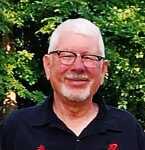- Honoring Troop E: A tribute to Missouri's dedicated highway patrolmen (12/26/24)
- Discover the hidden stories of Poplar Bluff's iconic McGruff the Crime Dog (12/19/24)
- Voices of these 'Singing Mules' were heard around the world (11/15/24)
- Poplar Bluff's women in railroad (11/8/24)
- Battleship Row: Maritime marvels in Poplar Bluff (11/1/24)
- David adopts a museum (10/25/24)
- Walking with Kati (9/12/24)

The last battle of WWII
The Poplar Bluff Museum tells many unknown tales of our community. I want to tell you some of those hidden tales found within the museum walls.
1945. Germany has surrendered. The war in Europe is over. It was now time to conquer Japan. Okinawa was the final step in MacArthur’s island hopping campaign to Tokyo. This was going to be the dress rehearsal for the invasion of Japan. On April 1, 1945, six divisions of Army and Marines hit the beach. They were supported by the largest armada of ships ever assembled in the history of warfare. This was bigger than D-Day.
Poplar Bluff was there. We had fought in every war and campaign since the Civil War. Okinawa had the most Poplar Bluff soldiers and sailors in one battle together.
Bill Hogg was on the aircraft carrier USS Bennington. His squadron of F4U Corsairs flew daily attack runs on Japanese positions. The Japanese tried to ram their largest battleship, the Yamato, onto the beach on a suicide attack. Hogg’s squadron helped sink the battleship before it reached its target.
Charles Morrison was on that beach. As an Army signal officer, he commanded a team who maintained a communications link to the Army units in combat.
Earl Suber was fighting inland. After a month in combat, he was killed by a Japanese sniper. It was the final days of the battle.
Ted Schalk was a torpedoman on the destroyer USS Little. They were running a screening mission on the outskirts of the fleet when they were attacked by 30 kamikaze aircraft. Four suicide planes struck the ship within 10 minutes. He was actually struck by the plane itself and severely wounded. He was thrown overboard and miraculously survived. The ship went down within minutes with 30 men still on board.
Bill Hicks was serving on the aircraft carrier USS Wasp. A Japanese plane dropped a bomb, striking the ship on its flight deck killing 200 men, Hicks included.
Fred Carr was with the Army 77th Infantry Division. He was involved in the fierce fighting on Hacksaw Ridge. He was wounded and his unit was forced to retreat, leaving him behind. As the Japanese regrouped on the ridge they began killing all the wounded soldiers. Miraculously, Carr was saved by his friend Desmond Doss. Doss pulled him to safety with 75 other wounded soldiers. Doss received the Medal of Honor for his actions and was the subject of the movie “Hacksaw Ridge.”
Four months later the fighting was over and the mop-up operations were going on across the island. Plans were being made for the invasion of Japan. On Aug. 6, the first atomic bomb was dropped, and a week later the war was over. Hogg sailed into Tokyo Bay and witnessed the surrender. Vernon Barwick also sailed to Japan from fighting in the Philippines. He was on an LST transporting occupation troops.
Had the invasion been required, you know Poplar Bluff would have been leading the way. Future generations of their sons and daughters have since served on Okinawa. Some are still there today. All these men are honored in the Kanell Hall Veterans Museum and the Poplar Bluff Museum Hall of Heroes. There are many other men who fought in the last battle that we still don’t know. Please let us know at the museum so we can honor them.
The museum is handicap accessible and open free of charge from 1-4 p.m. Sundays at 1010 Main St. Tell them Mike sent you.
Mike Shane is a veteran, Poplar Bluff resident and board member for the Poplar Bluff Museum.
Posting a comment requires free registration:
- If you already have an account, follow this link to login
- Otherwise, follow this link to register
